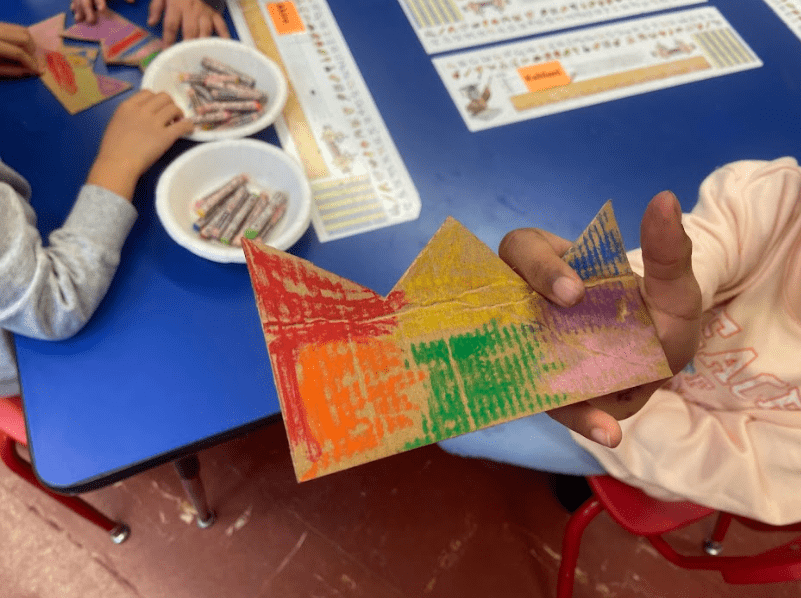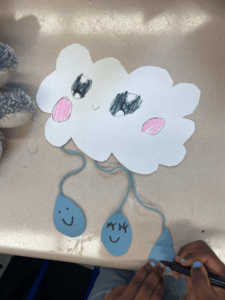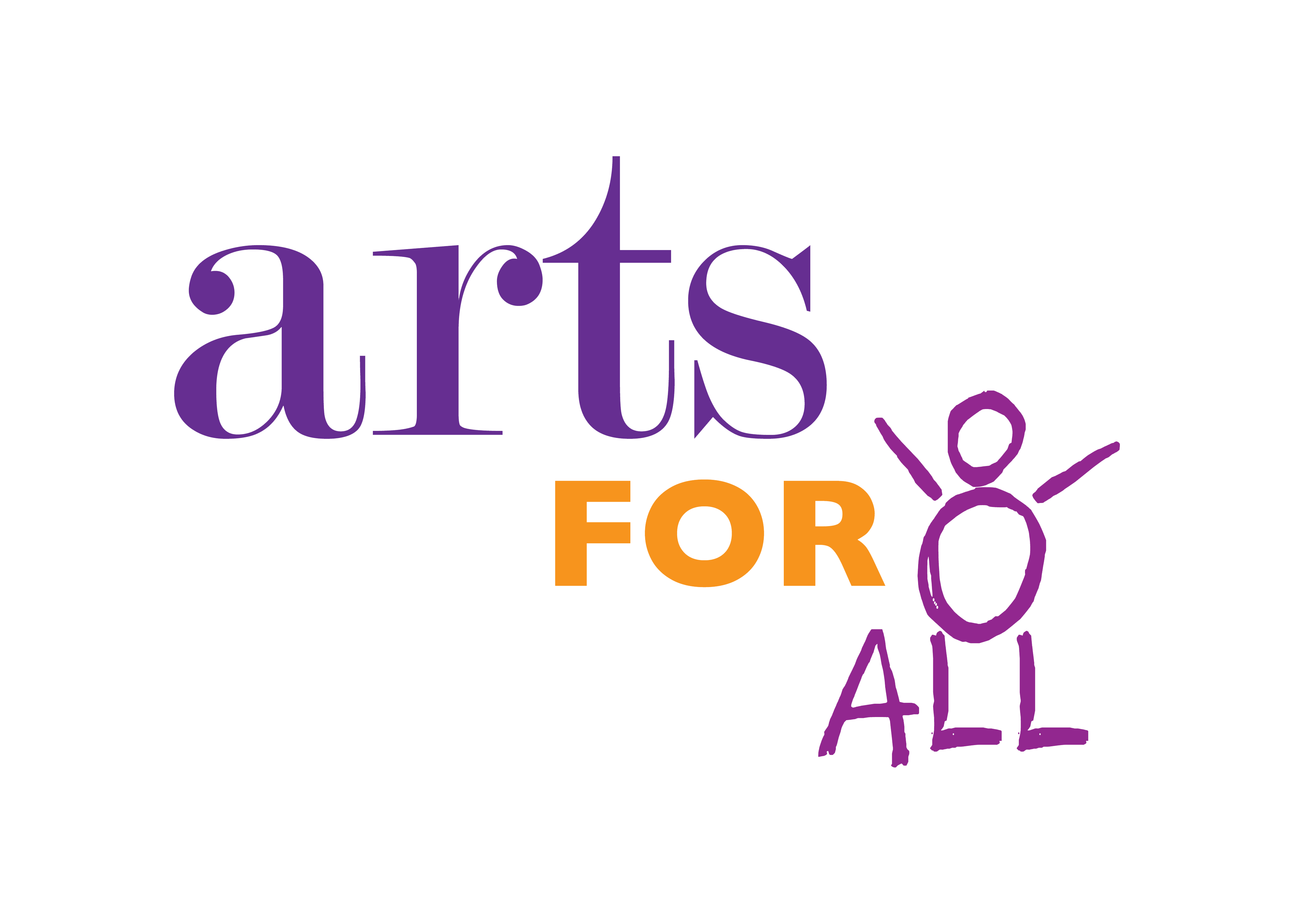Written by AFA Spring 2023 Intern Melody Fay Browning
February 7th, 2023

Photo By Melody Fay Browning
On Tuesday, February 7th I had the joy of joining teaching artist Briget Villanueva for several kindergarten and first grade classes at PS 15. Briget’s class was focused on the book “Life Doesn’t Frighten Me,” which is a combination of a poem by Maya Angelou and illustrations by Jean-Michel Basquiat. The class then looked at images of Basquiat’s work and pointed out things that they noticed. Briget asked what a lot of the images had in common, and the children pointed out that many of the artworks had crowns on them. It was very funny to hear the children try to pronounce Basquiat’s name and it seems they all had their own way of saying it. The classes then made their own Basquiat inspired crowns out of cardboard and string that they could wear on their own heads. They cut out the traced points on the cardboard to make the crowns and then used oil pastels to color them, referencing back to Basquiat’s art that Briget provided as examples of his style. After craft time, Briget asked the children what the trickiest park was, and many of them said cutting with the scissors was the hardest. Briget said that just means we can keep practicing and it will get easier. She then asked what the most fun part was, and the classes all agreed coloring with the oil pastels was the most fun. It was so fun for me to see the children be inspired and truly enjoy the art of such an iconic artist and then use that to create something they were proud to wear.
Teaching Artist Briget Villanueva Interview Part 1:
Q: What factors do you think about when developing your lesson plans?
Briget: When I’m mapping out my lesson plans, I always start by considering what the teachers are interested in having their students explore and what skills need to be nurtured. I also observe and talk to students the first week or two to get a gauge on how to refine the final curriculum for the semester. I try to plan for a variety of art mediums to introduce to the class as well, especially if they’ve never had a chance to experiment with specific materials.
Q: How do you navigate classrooms with children that are at different levels of learning and skill?
Briget: One of the most important things I do in all of my classes is spend one on one time with each student during the art-making process. Every student processes and creates at their own pace. It’s so essential that each student is given a chance to use their voice to validate their autonomy. I make sure to check in on them whenever they struggle so I can guide them at their pace. Additionally, if they have classmates who have a clearer understanding and grasp of the assignment, I encourage them to help each other out and give students the opportunity to be a teacher themselves.
Q: What do you hope children in your classes take away from your lessons?
Briget: As an artist and educator, I hope that I can successfully provide a safe and nurturing creative outlet for my students. There’s a responsibility to ignite a spark in them no matter what their story. My priority is to foster a positive environment for them to freely express themselves so their experiences and skills can thrive beyond the arts. I want them to know their voice is the center of the narrative.
April 4th, 2023

Photo By Melody Fay Browning
On Tuesday, April 4th I had the pleasure of joining teaching artist Brigit Villanueva for several kindergarten and first grade classes at PS 15. Briget’s classes focused on the book “The Little Raindrop,” which is about the cycle of a raindrop when it leaves the raincloud. The classes talked about the cycle of the raindrop and how in the story the little raindrop ended up in all sorts of adventures, like landing on a flower before finding its other friends. Briget then led the children through creating their own rainclouds and raindrops inspired by the story. They could create any design on the cloud, and most chose to give it some sort of face like in the book. The used yarn and glue to attach the raindrops to create the final art piece. They then gathered to share their rainclouds and each child explained how they chose to decorate their art piece. It was a lot of fun to join Briget today because the classes were so engaged and excited to create the craft Briget planned. It was great to see the way the children all put their own spin on it and were proud of what they created.
Teaching Artist Briget Villanueva Interview Part 2:
Q: When working with children at such a young age in early stages of learning, have you discovered that there are any tools that either work really well for you or don’t work at all?
Briget: Definitely if there’s a way to grab their attention, to keep them engaged. So first, I really like how each class has their own special call and response to grab their attention and then hopefully get their focus on you. Because sometimes with big classes you can’t always get them on the same page at the same time. So that’s helpful. With smaller classes it is easier. I also like quick games. to freshen up or get their energy out. But sometimes you have to pick and choose with every class because everyone’s different.
Q; I noticed in the first lesson I observed where you incorporated Basquiat’s art into the lesson that you seem to be interested in incorporating art history into your lessons as well as the actual hands-on art making portion of the lesson. Could you tell me a little bit about why you think that’s important for the children you work with?
Briget: I don’t always get to use a particular artist. What I do first with the curriculum, again, is based on what the teachers want. Whether that’s based on what they’re learning in their curriculum at that time. Sometimes it’ll require an artist, sometimes they want to focus on science. Whatever it may be. But when I have an opportunity to incorporate an artist in whatever specialty, say for doing painting or something that’s portraits and for the Basquiat lesson, it was Black History Month. I like to incorporate that, that way they’re exposed to artists who can bring out something that they’re interested in, who also may look like them. They’re growing up and it’ll expose them to different ways to express themselves. So when I can, I like to, I don’t always get to, but growing up as an artist myself, that’s the best way to figure out what I like when it comes to art.
Q: You mentioned in your answers to my case questions that you want your students to thrive beyond the arts. Can you talk a little bit about how you think the arts and specifically your lessons can provide tools to help your students do that?
Briget: With my specialty being visual arts, not all students get to do the arts in their school or it’s not that explored. Or we try to bring materials that they might not have here because they don’t have the resources. Again, it’s that conversation with the teachers of what do you want them to explore? What do you think they need to work on, and is there something that you think that they really enjoy exploring too? That way it helps them learn that “oh, I really like this. Oh, I want to do something with this.” And sometimes some kids don’t like art. And that’s okay too. As long as we give them that outlet and that space to express themselves, I’m glad that we’re able to do that.
